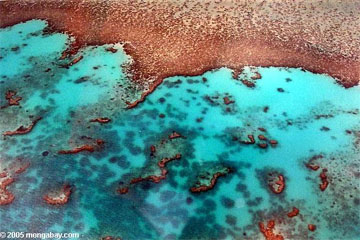“Weird” algae key to survival of coral reefs
“Weird” algae key to survival of coral reefs
ARC Centre of Excellence in Coral Reef Studies
August 31, 2007
|
|
A team of coral researchers has taken a major stride towards revealing the workings of the mysterious âengine’ that drives Australia’s Great Barrier Reef, and corals the world over.
The science has critical importance in understanding why coral reefs bleach and die, how they respond to climate change — and how that might affect humanity, they say.
Scientists at the ARC Centre of Excellence for Coral Reef Studies, James Cook University and the University of Queensland have compiled the world’s first detailed gene expression library for Symbiodinium, the microscopic algae that feed the corals — and so provide the primary energy source for the entire Reef.
“Symbiodinium uses sunlight to convert CO2 into carbohydrates for the corals to feed on. At the same time there’s evidence the corals control its output, suggesting that they are farming their captive plants” Professor David Yellowlees explains.
 Great Barrier Reef in Australia Related articles Global warming is killing coral reefs. (5/7/2007) A new study provides further evidence that climate change is adversely affecting coral reefs. While previous studies have linked higher ocean temperatures to coral bleaching events, the new research, published in PLoS Biology, found that climate change may increasing the incidence of disease in Great Barrier Reef corals. Omniously, the research also shows that healthy reefs, with the highest density of corals, are hit the hardest by disease. Carbon dioxide levels threaten oceans regardless of global warming. (3/8/2007) Rising levels of carbon dioxide will have wide-ranging impacts on the world’s oceans regardless of climate change, reports a study published in the March 9, 2007, issue of the journal Geophysical Research Letters. Coral reefs decimated by 2050, Great Barrier Reef’s coral 95% dead. (11/17/2005) Australia’s Great Barrier Reef could lose 95 percent of its living coral by 2050 should ocean temperatures increase by the 1.5 degrees Celsius projected by climate scientists. The startling and controversial prediction, made last year in a report commissioned by the World Worldwide Fund for Nature (WWF) and the Queensland government, is just one of the dire scenarios forecast for reefs in the near future. The degradation and possible disappearance of these ecosystems would have profound socioeconomic ramifications as well as ecological impacts says Ove Hoegh-Guldberg, head of the University of Queensland’s Centre for Marine Studies. |
“But these microscopic algae are quite weird and unlike any other lifeform. They have different photosynthetic machinery from all other light harvesting organisms. They have 100 times more DNA than we do and we have no idea why such a small organism needs so much. They really are like no other living creature we know.
This is echoed by team member Prof Ove Hoegh-Guldberg who comments it is âlike no other organism on planet’, jokingly labeling it “like an alien”.
This strange beast not only rules the fate of the world’s coral reefs — it also plays a significant role in soaking up carbon dioxide from the atmosphere, turning it into nourishment for the corals and powering calcification. Its decline would not only kill the reefs but accelerate CO2 buildup.
Dr Bill Leggat says the team has focused particularly on understanding the biochemical relationship between Symbiodinium and corals when they are stressed by heat, light, increased CO2 levels and pollutants from land run-off.
These stressful conditions cause corals to âbleach’ by expelling the Symbiodinium and — if they do not recover them within a few days — the corals die. Large-scale bleaching struck half of the Great Barrier Reef in 2002, and eight major bleaching episodes have been reported worldwide in the last 30 years due to warming sea water.
“Our aim is to identify the genes that make the symbiotic plants susceptible to these stresses, and lead to the coral expelling them,” Dr Leggat says.
In experiments at Heron Island Research Station they exposed corals to various stresses associated with climate change and then analysed the gene composition in the symbiotic algae. Another team analysed the effects in corals.
Working together and using the powerful micro-array technology, they hope to assemble a picture of the âchemical conversation’ that goes on between the corals and its symbiotic plants that leads to a breakdown in the relationship, a divorce – and the corals starving themselves to death.
“An example of the challenge we face is the gene which is expressed the most when Symbiodinium is stressed. It’s obviously important – but at this stage we have no idea what it does. It is even stranger when you consider that this gene was originally acquired from a bacterium” Prof Yellowlees says.
So far the team has identified about 4500 genes in Symbiodinium, compiling them into the world’s first gene expression library for this symbiotic organism. It is hoped this will have value for understanding other symbiotic relationships in nature.
Symbiodinium is part of a larger group of organisms called dinoflagellates, responsible for events like red tides and ciguatera poisoning. Together, the dinoflagellates process about one third of all CO2 entering the oceans — and are thus vital players in helping to remove CO2 from the atmosphere. Understanding how they function will help fill in one of the critical gaps in our understanding of climate change — how much CO2 the oceans can trap and how this will affect ultimate climate change.
Details of the team’s research findings will be published in the Journal of Phycology later this year.